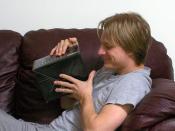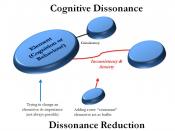Running head: COGNITIVE DISSONANCE-PERILS OF THE POOR � PAGE \* MERGEFORMAT �1� COGNITIVE DISSONANCE-PERILS OF THE POOR � PAGE \* MERGEFORMAT �7�
Cognitive Dissonance-Perils of the Poor
Learning Team D:
Bonnie Marcum-Pruitt, Shayolanda Herron, Teresa Whitehead
University of Phoenix
Social Psychology
PSY/400
Julee Poole
June 07, 2010
�
�
Cognitive Dissonance-Perils of the Poor
Matthew Blakely was a good and hardworking man who would give a person the shirt off his back. The following is the account of how this hardworking family man could make the decision that triggered the chain of events that eventually would violate his cognitions of values, beliefs, attitudes, and morals. There are social, cultural, and spiritual influences not only on Matthew's behavior but also on his personal ethics, and there is a reciprocal relationship between his behavior and attitudes. Matthew used cognitive dissonance theory to rationalize his behavior because he was uncomfortable with his decision, and felt guilt, anger, and frustration at not being able to come up with a different outcome.
Matthew was sure that this decision was the right decision for his family.
The Situation
Matthew Blakely began as a construction worker straight out of high school, and was proud of the accomplishments and salary he made. As long as Matthew could provide for his wife and family, all was well at home. The Blakely family attended church every Sunday, and Matt (as friends called him) even joined the choir. Matt loved his family, and loved to get together to watch sports with his friends. Many of Matt's friends began losing their jobs when the economy took a turn for the worse, and would come to Matt for help. Matt helped as much as he could, but was laid off from his job and could not seem to get another job.


